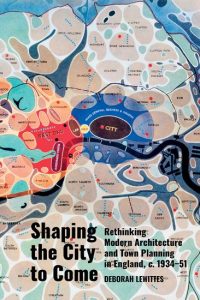
Drs. Vuagniaux and Ortuño will present papers at the Annual RSA Conference as part of a panel, “Domestic Dynamics in the Creation, Collection, and Display of European Art, 1350–1650,” which seeks to expand the canon of early-modern artworks that are inextricably connected to the domestic realm. Their research examines home, marriage, and family across various media, from the so-called decorative arts to monumental works that traditionally fall outside of the purview of domestic art. Ceramics and furniture with decoration not typically linked to such concepts will be considered through the lens of domestic dynamics, as will private collections and public monuments from various parts of Western Europe.

Deborah Lewittes (Associate Professor of Art History) published her new book in 2022. Shaping the City to Come: Rethinking Modern Architecture and Town Planning in England, c. 1934-51 (Liverpool University Press) reassesses mid-twentieth-century England, highlighting ideas and debates that were in circulation as continental modernist ideals gradually took root in a new environment. The book reveals an interwar architectural culture that was serious, active, and visionary, with impact that extended into the postwar years. Through close studies of specific works and writings, the book acknowledges the importance of the international context of modern architecture as it intersected with the variety of narratives that defined English modernism, such as national identity, the New Empiricism, and the picturesque, taking into account the large community of émigré architects who settled in England with the approach of World War II, as well as a more general dissemination of international style forms and theories from elsewhere in Europe. The book places familiar figures such as Berthold Lubetkin and Ernö Goldfinger as well as projects such as Tecton’s Penguin Pool and the Festival of Britain’s “Live Architecture” Exhibition in new light, presenting a rich picture of the modern architectural climate in England. The study draws attention to the debates, proposals, and processes that fed into the development of modernist, urban-minded, and forward-looking architectural thought.
Dr. Lewittes also just received a 2023 PSC-CUNY research grant to support travel to London for her new project on the work of the Berlin-born English sociologist Ruth Lazarus Glass. This project will be the first attempt to link Glass’s writing and thinking to architectural and urban debates in the thirties and forties. Although she is celebrated for having coined the term “gentrification” in the sixties, Glass was active in English sociology circles from the moment she fled Nazi Germany in 1933 and came to London, analyzing housing estates and architectural works in social terms. In Glass, many significant strands come together – she was female, foreign, and Jewish in a culture that was antisemitic, xenophobic, and – at least in the academic environment in which she worked – often misogynistic as well. Glass navigated these waters with an unparalleled intellect, and this new study will analyze the importance of her writing from the angle of art and architectural history.
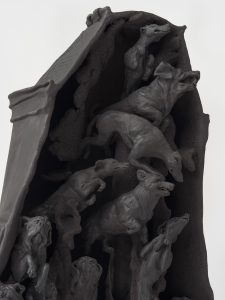
In Purebred, her recent series of ceramic sculptures, Gwyneth Scally reflects on the human relationship with nature by considering our history with dogs as a touchstone for the animal world.
“I genuinely, sincerely, and completely adore dogs, and yet I am fascinated by the human––and especially the English Victorian––concept of the “purebred” and what this says about our manipulation of the natural world as a way to signify our own cultural identity,” says Scally. “In these works, clay––the most natural of materials, as it truly is just dirt––slumps and collapses in a sort of organic decomposition. This formal looseness contrasts with the highly rendered, vital energy of the running, wriggling, struggling shapes of the dogs. The dogs are mostly English bulldogs and lurchers (a medieval hunting dog related to the greyhound). They are highly bred and genetically manipulated, yet these wonderful animals express total agency and unpredictability. Like nature as a whole, they are beyond human control.”
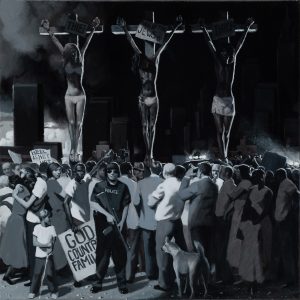
The Passion of Christ is a series of twenty paintings showing the events of the Passion and Resurrection. It is the second of two such series Frank D. Blanchard has painted. The first was begun in 2001 and completed in 2005. It was comprised of twenty-four wooden panels. This series was seven years in the making, beginning in 2016 and completed this year.
“I decided to make a slightly shorter series, twenty panels instead of twenty-four,” Blanchard explains. “I painted them on canvas instead of wood panels and made them slightly larger in a square format. I decided to paint the bulk of the series in monochrome, and later parts after the Resurrection in full color. The historic experiences of LGBTQ persons and non-white people in the USA inform this new Passion series. I am a gay man, and like the rest of the LGBTQ+ community, I’ve directly felt the experience of being despised and rejected. Too many in the LGBTQ+ community and too many persons of color in the USA walked a literal Via Dolorosa to its fatal end. Another consideration [of the series] is mortality. I am many years older than I was when I started painting the first series. As years go by, I feel the losses of so many friends and family more keenly. Those issues of mortality and immortality, time and timelessness, death and resurrection at the center of this story have a new resonance for me now. If the new series has a guiding theme, it is that of Emmanuel, God is with us; God in solidarity with us as we suffer misfortune and injustice in the struggles for power that make up mortal life. I hope that a wide variety of people who are not like me (including the differently religious and non-religious) can see themselves and some of their own experiences in this new series.”
The Passion of Christ will be on display at Revelation Gallery, 224 Waverly Place, New York, NY. The exhibition is open from September 6 th through September 30 th , 11AM to 3PM Monday through Friday, with an artist’s reception on September 23 rd , 6 to 8PM.
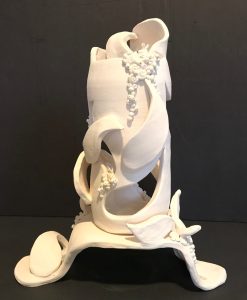
Mebuki (Sprouting), ceramic, h. 16 inches, w. 14 inches, d. 7 inches, 2022.
Throughout 2018, Florence Tanaka-Kuwashima created pieces for a series of works inspired by Tokonoma , the Japanese tradition of providing houses with an art alcove. In this shallow, stage-like space, built of unrefined natural materials and never occupied by people, a work of exquisite pottery (often a flower vase) is set in front of a painted or embroidered scroll hung from a back wall. Tanaka-Kuwashima exhibited her Tokonoma constructions as well as watercolors and other ceramic pieces at a one-woman show at the Hendrick Hudson Library in Montrose, New York.
While working on thrown and open form vases for her Tokonoma series, the pieces she created led to an unanticipated development. As she experimented with clustered plant motifs and other natural forms, the vases morphed into sculptural work. Tanaka has named these new pieces Mebuki –– the Japanese word for “sprouting,” and hopes to exhibit her Mebuki sculptures when she completes the full series.
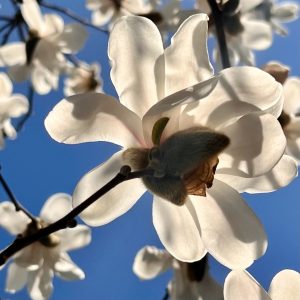
Magnolias, Digital Photography, 2023
This month, Roni Ben-Nun (Associate Professor and Chair of the A rt and Music Department) received the Bronze Award at the Artist Invitational IV, International Juried Visual Arts Exhibition at the Camelback Gallery (Scottsdale, AZ) for his photograph, Magnolias . In this work, which celebrates the end of a long winter and the coming of spring, Prof. Ben-Nun captured the afternoon sun playing on magnolia petals as the day wanes.